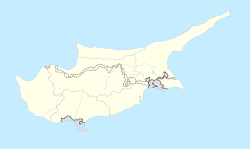Idalium
| Ιδάλιον | |

Map showing the ancient city Kingdoms of Cyprus. Idalion is inland at center right
|
|
| Location | Cyprus |
|---|---|
| Region | Nicosia District |
| Coordinates | 35°00′57″N 33°25′23″E / 35.0158°N 33.4230°ECoordinates: 35°00′57″N 33°25′23″E / 35.0158°N 33.4230°E |
Idalion or Idalium (Greek: Ιδάλιον, Idalion) was an ancient city in Cyprus, in modern Dali, Nicosia District. The city was founded on the copper trade in the 3rd millennium BCE. Its name in the 8th century BCE was "Ed-di-al" as it appears on the Sargon Stele of 707 BCE, and a little later on the .
The original inhabitants were the natives of the island, known to scholars as the "Eteocypriotes". The original city lay on the northern side of the Yialias River in modern "Ayios Sozomenos". During the 13th century BCE the people of Ed-di-al began manufacturing operations on the south side of the river in what is now modern Dhali. From there the city grew to the major urban and copper-trading center founded by the Neo-Assyrians at the end of the 8th century BCE.
Idalion was among the 11 cities of Cyprus listed on the Stele of Sargon (707 BCE) and first among the ten Cypriot kingdoms listed on the prism (many-sided tablet) of the Assyrian king Esarhaddon (680–669 BCE). These 10 cities are listed as Idalion, Chytroi, Soloi, Paphos, Salamis, Kourion, Tamassos, the "New Town", Ledrai and “Nuria”.
The first evidence of non-Cypriote presence (Greek, Phoenician, and others) appears in the Archaic Period (c. 550 BCE) in Phoenician inscriptions found in the Adonis Temenos on the East Acropolis.
Cypro-Syllabic script (11th to 2nd century BCE) was deciphered based on the Cypriot-Phoenician bilingual text of Idalion. Starting with the Cypriot-Phoenician bilingual text of Idalion (a dedication to the god Reshef Mikal – identified as Apollo Amyklos – 4th century BCE), George Smith carried out a first attempt at interpretation in 1871, later developed and improved, thanks also to the Idalion Tablet, by the Egyptologist Samuel Birch (1872), the numismatist Johannes Brandis (1873), the philologists , , Justus Siegismund (1874) and the dialectologist H.L. Ahrens (1876).
...
Wikipedia

